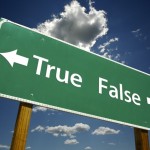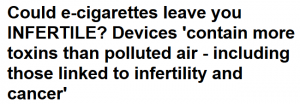[vc_row][vc_column][vc_separator][vc_single_image image=”1254″ img_size=”medium” align=”vc_align_center”][vc_column_text]In what is a spectacular example of how bad science can go ‘viral’ with scaremongering and baseless headlines, today we’d like to talk about Hong Kong.
A story published yesterday in the South China Morning Post reports that researchers from Hong Kong’s Baptist university looked at 13 e-cigarette products which were available on the local market, and found polycyclic aromatic hydrocarbons (PAHs) at levels of 2.9 to 504.5 ng per mL (ng/mL).
Now, nowhere in the reporting does it mention the names of the brands of products, nowhere does it suggest where the research has been published,nowhere does it mention the methodology of the study, and nowhere in the story does it mention the levels of PAHs commonly found in outdoor air in Hong Kong.
It goes without saying then, that these headlines are unwarranted:
Once this story reached the shores of the UK and the desk of The Daily Mail, the headline got even more alarmist:
Dr Konstantinos Farsalinos has taken a look at the story and filled in some of the blanks in a blog post yesterday:
”First of all, the definition of PAHs is: “a class of environmental pollutants created primarily from incomplete combustion of various organic materials including tobacco”. We all know that there is no complete or incomplete combustion of any material in e-cigarettes, so I really doubt whether their findings are valid.”
Dr Farsalinos did a quick literature search to find the levels of PAHs in outdoor air in Hong Kong, and
”…found a paper from 1998, finding levels of PAHs up to 48 ng/m3 (cubic meter = 1,000,000 (million) mL) in Hong Kong. So, the levels in outdoor air are 48 ng per 1,000,000 mL. Obviously the scientist quoted in the media story compared mLs of air with mLs of e-liquid.
The average volume of air breathed daily by humans is 20m3 (=20,000,000 mLs). Contrary to that, an average vapers consumes 3mLs of liquid (according to our survey). Thus, the levels in outdoor air in Hong Kong would result in total daily exposure of 960 ng.
The levels of exposure from e-cigarette liquids (as tested by the Hong Kong university and assuming they are correct) are 9-1500 ng.
This is from 99% less up to 50% more than exposure to outdoor air (or, to express it differently, 100 times less to ½ time more).”
And his opinion on the statement asserted in the headlines?
1,000,000 times higher levels” is complete false.
He further discusses the other glaring error in the researchers’ study as it’s reported:
”First, tobacco cigarettes are solid, not liquids or gas. Thus, there is no mL of tobacco cigarettes, they should mention weight of tobacco. But here is the catch: tobacco cigarette smoke is known to contain about 1.6 ug PAHs per cigarette (that is, 1600 ng/cigarette).
But how can you compare mLs of inhaled tobacco cigarette smoke with mLs of e-liquid? It is simply a joke. The truth is that 1 tobacco cigarette contains by far more PAHs than what they reported they found in 1 mL of liquid (which is 1/3rd the daily consumption).”
In what on the surface looks like ”policy based evidence making”, Dr Chung Shan-shan, assistant professor in the university’s biology department is quoted as describing the situation ”worrying”.
The Hong Kong Council on Smoking and Health, which commissioned the study, is using the results of it to call for a ban on e-cigarettes – which seems to fly in the face of both the current existing evidence base, and also how to properly formulate policy on a product that is helping millions of people worldwide reduce their harm from smoking.
Dr Farsalinos’ opinion?
”…either the scientists have no idea about what they are talking about, or they are deliberately misinforming the public and the regulators.
Even worse, they are creating panic to vapers (the vast majority of whom are former smokers), with the risk of making them relapse to smoking. This is a typical case of gross misinformation and extremely poor science. Literally, a public health disgrace…
The reporters of this “study” (not authors, because there is no published study) need to immediately apologize to the public for creating this story out of nothing.”
[/vc_column_text][/vc_column][/vc_row]





